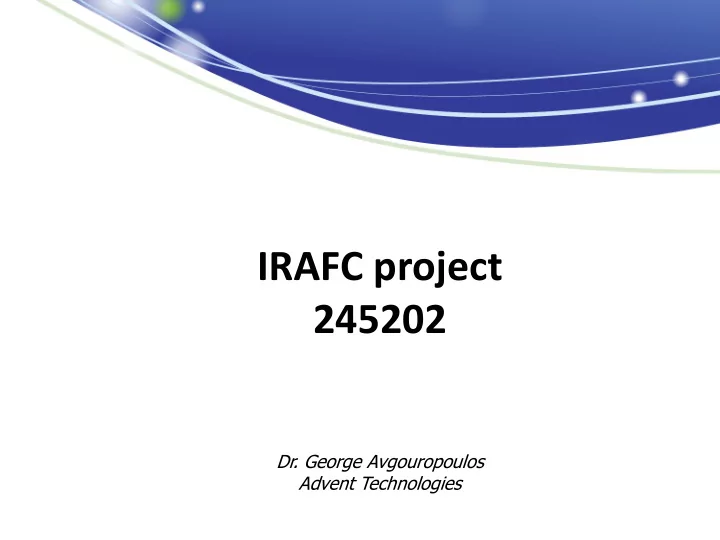

IRAFC project 245202 Dr. George Avgouropoulos Advent Technologies
Consortium Advent Technologies (Coordinator) Greece R&D and production of MEAs University of Maria Curie- Sklodowska , Department of Chemical Technology UMCS , Poland Preparation, studying and characterization of catalysts Nedstack Fuel Cell Technology BV , The Netherlands Producer of PEM fuel cell stacks and systems Centre National de la Recherche Scientifique , Laboratory of Materials, Surfaces and Catalytic Processes (LMSPC) France Preparation of new catalytic materials, catalytic reactivity, kinetic studies and surface science, new energy sources,electrocatalysis and fuel cells Foundation for Research and Technology Hellas-Institute of Chemical Engineering & High Temperature Chemical Processes , Greece High and low temperature electrochemistry, heterogeneous catalysis, chemical and electrochemical kinetics and reactor design Institut für Mikrotechnik Mainz GmbH , Germany Research and development in microtechnology _____________________________________________________________________________________ Start date:01/01/2010 End date: 31/12/2012 Total budget : 2.529.625 € , FCHJU contribution: 1.424.147 €
The ultimate goal of the project is to deliver: - An Internal-Alcohol-Reforming High-Temperature PEM fuel cell (IRAFC) with the following characteristics: (i) 0.15 W/cm 2 at 0.7V, operating at 220 ° C (ii) Specific (W/kg) and volumetric (W/m 3 ) power density similar to current, state-of-the-art high-temperature PEM fuel cells operating on hydrogen.
STRATEGY AND MILESTONES MEA operating at temperatures 200-220 ° C Methanol reforming catalysts active at 200-240 ° C Optimum combined fuel cell and reformer stack design Reliable system performance at 200-220 ° C for 500hrs
WP1: Management Research Activities WP3: Reforming catalyst: WP2: Synthesis and characterization of novel synthesis and screening high temperature polymer electrolyte membranes WP5: Electrochemical WP4: Catalytic formulations characterization of materials into functional structures WP7: Construction, long term testing of short stacks and integration of a 100W stack to a complete system WP6: Single cell, stack design and testing WP8: Dissemination, Exploitation and management of IPRs
Preparation of new crosslinked membranes Bisazide method Crosslinking in acid
MEA stability test 200 ° C MEA stability test 210 ° C • No degradation observed at 200 ° C for 48hrs • Stable performance at 210 ° C for 550hrs
CuMnAlO results in More than threefold increase in catalytic rate than x CuMnO x 20 100 CuMnO x CO selectivity, % MeOH conversion, % CuMnAlO x 15 solid symbols: 5% MeOH/7.5 %H 2 O/He 80 open symbols: 20% MeOH/30 %H 2 O/He W=0.3 g 60 10 F=70 cc/min CuMnAl/Cu foam (5x5x0.3 cm) o C, single cell 200 40 30% MeOH/45% H 2 O/He 5 20% MeOH/30% H 2 O/He 10% MeOH/15% H 2 O/He 20 5% MeOH/7.5% H 2 O/He 0 -1 0 180 200 220 240 260 280 300 -1 g 3 min 100 40 MeOH conversion, % H 2 production rate, cm 80 30 60 20 40 20 10 0 0 180 200 220 240 260 280 300 0,0 0,5 1,0 1,5 2,0 2,5 3,0 3,5 4,0 4,5 5,0 5,5 o C -3 T, Contact time, g s cm
Different combined single cell architectures Internal reforming alcohol single cell have been tested Internal Reforming Methanol Fuel Cell Internal Reforming Methanol Fuel Cell Graphite Graphite HT-Polymer HT-Polymer Plate Plate Al Plate Al Plate Electrolyte Electrolyte Flowfield Flowfield Current Current Membrane Membrane Collector Collector H H H methanol methanol O O O oxygen oxygen H C H C H C O O O & water & water O O O H H H H H H H + H + H H H H H H H + H + O O O H + H + H H H H + H + H H H H H H O O O H H H O O O water water O O O carbon dioxide carbon dioxide C C C & water & water O O O Anode: Pt/C Anode: Pt/C Cathode: Pt/C Cathode: Pt/C CuMnO/Cu foam catalyst CuMnO/Cu foam catalyst CuMnOx/Cu foam H 2 → 2H + +2e - H 2 → 2H + +2e - 0.5O 2 +2H + +2e - → H 2 O 0.5O 2 +2H + +2e - → H 2 O CH 3 OH+H 2 O → 3H 2 +CO 2 CH 3 OH+H 2 O → 3H 2 +CO 2 MEA and CuMnO x /Cu foam catalyst Modified Graphite Plate (Anode)
BoP components
CAD model of the final system Dimensions: L 600 mm W 250 mm H 255 mm Volume 38.25 L (incl. Insulation +DC/DC converter + control board) Comparison: On market system (250 W) L 600 mm W 400 mm H 250 mm Volume 60 L
IRAFC System advantages: Application areas: • Easy fueling • Portable fuel cells • Use of liquid fuel • Stationary Back up and UPS systems • Compact design • Remote and off grid areas • Combination of reformer/fuel cell • Multi application In agreement with early markets application areas goals
Technology transfer: Highly interdisciplinary approach since the consortium consists of companies and academic institutes whose expertise cover a broad range of activities Interface with international and national research projects, e.g.: - DEMMEA -245156 - 09- ΣΥΝ -51-453 - Eurostars E!5094 Future perspectives: Exploitation of the system application in: - Refrigerators in remote and off grid areas - Stationary back up power systems
Dissemination & public awareness: • 15 publications in peer reviewed journals • Participation in 22 conferences and events • 1 patent application • Website dedicated to IRAFC project (http://irafc.iceht.forth.gr/index.php )
Recommend
More recommend